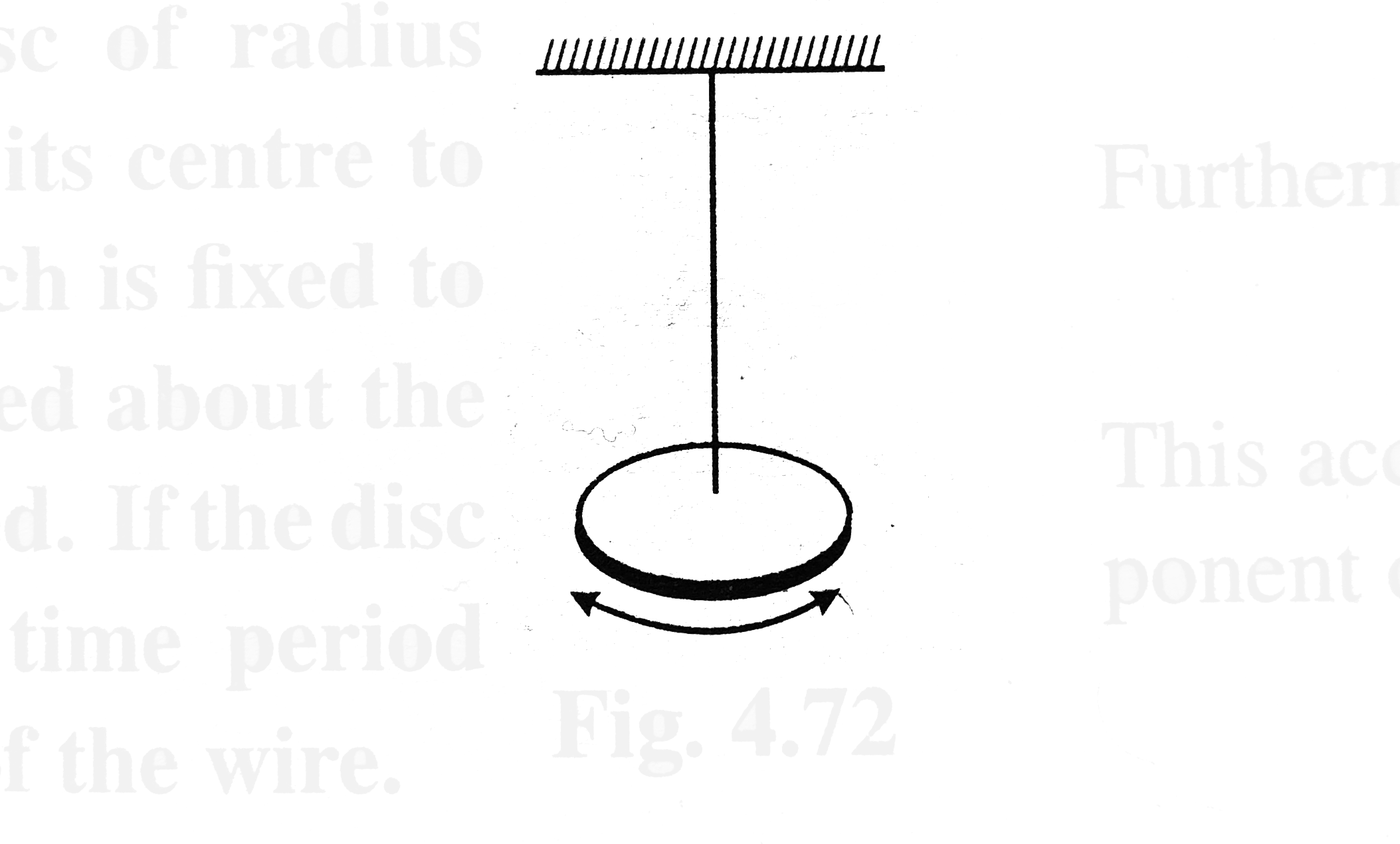A circular disc of mass 10kg is suspended by a wire attahced to its centre. The wire is twisted by rotating the disc and released. The period of torsional oscillations is found to be 1.5s. The radius of the disc is 15cm. Determing the torsional spring constant of the wire. (Torsional spring constant α is definied by the relation J=−αθ, where J is the restoring coubple and θ the angle of twist.
Here, m=10kg,R=15cm=0.15m,T=1.5s,α=?
Moment of inertia of disc, I=12mR2=12×10×(0.5)2kgm2
Given, restoring couple, J=−αθorJ∝θ and this couple tends to bring the disc back to its equilibrium position. Therefore if the disc is left free after twist, it will execute angular SHM with equilibrium position as mean position. Then time period is give by
T=2π√Iα So, α=4π2IT2=4×(227)2×12×10×(0.15)2(1.5)2=1.97Nm/rad
Topper's Solved these Questions
- OSCILLATIONS AND WAVESBOOK - PRADEEPCHAPTER - OSCILLATIONS AND WAVESEXERCISE - NCERT CHAPTER
26 Videos
- OSCILLATIONS AND WAVESBOOK - PRADEEPCHAPTER - OSCILLATIONS AND WAVESEXERCISE - Higher Order Thinking Skills
13 Videos
- OSCILLATIONS AND WAVESBOOK - PRADEEPCHAPTER - OSCILLATIONS AND WAVESEXERCISE - NCERT EXERCISES WITH SOLUTIONS
19 Videos
- MATHEMATICAL TOOLSBOOK - PRADEEPCHAPTER - MATHEMATICAL TOOLSEXERCISE - Fill in the blanks
5 Videos
- PHYSICAL WORLD AND MEASUREMENTBOOK - PRADEEPCHAPTER - PHYSICAL WORLD AND MEASUREMENTEXERCISE - Competiton Focus Jee Medical Entrance
18 Videos
Similar Questions
A circular disc of mass 12 kg is suspended by a wire attached to its centre. The wire is twisted by rotating the disc and then released, so that the time period of torsional oscillation is 2 s. If the radius of the disc is 10 cm, then calculate the torsional spring constant of the wire.
View SolutionA disc of mass 'm' is suspended at a point R/2 above its centre. Find its period of oscillation.
View Solution
Knowledge Check
A thin uniform rod of mass 1 kg and length 12 cm is suspended by a wire that passes through its centre and is perpendicular to its length.The wire is twisted and the rod is set oscillating. Time period of oscillation is found to be 3 s. When a flat triangular plate is suspended in same way through its centre of mass, the time period is found to be 6 s. The moment of inertia of the tringular plate about this axis is
A0.12kg−m2B0.24kg−m2C0.48kg−m2Dinformation insufficientA disc of radius R is suspended from its circumference and made to oscillate. Its time period will be:
A2π√3R2gB2π√4RgC2π√RgD2π√2RgIf there is no torsion in the suspension thread, then the time period of a magnet executing oscillation is:
AT=12π√MB1BT=12π√1MBCT=2π√IMBDT=2π√MBI
A uniform disc of mass m and radius r is suspended through a wire attached to its centre. If the time period of the torsional oscillations be T, what is the torsional constant of the wire?
View SolutionWhat is torsional constant of the spring used in a galvanometer?
View SolutionA uniform disc of radius 5.0 cm and mass 200g is fixed at its centre to a metal wire, the other end of which is fixed with a clamp. The hanging disc is rotated about the wire through an angle and is released. If the disc makes torsional oscillations with time period 0.20s, find the torsional constant of the wire.
View Solution(a) A uniform disc of radius 5⋅0cm and mass 200g is fixed at its centre to a metal wire, the other end of which is fixed with a clamp. The hanging disc is rotated about the wire through an angle and is released. If the disc makes torsional oscillations with time period 0.20s, find the torsional constant of the wire.
(b) In the previous part, another disc is placed over the first one and the time period of the system become 0.65. Find the M.I. of the second disc about the wire.
View SolutionA uniform of radius 5.0cm and mass 200g is fixed at its centre to a metal wire , the other end of which is fixed to a celling. The hanging disc is rotate about the wire through an angle and is released. If the disc makes torsional oscillations with time period 0.20s , find the torsional constant of the wire.

View Solution
